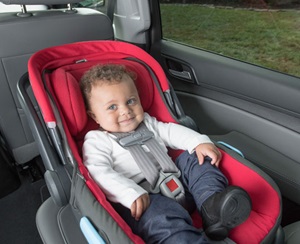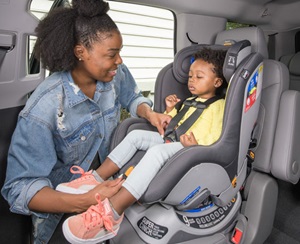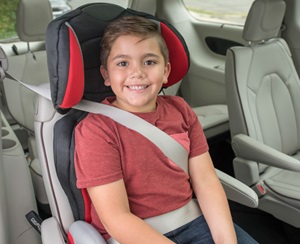
Did you know that 9 out of 10 car seats are used incorrectly? Whether you are expecting your first baby or have a car full of kids, selecting and properly using a child safety seat can be a challenge.
The type of seat your child needs depends on multiple factors, including your child’s age, height, weight, and developmental needs. You may also need to take into consideration the type of vehicle you will be transporting your child in, and the safety needs of other passengers.
With so many factors to consider, we strongly recommend making an appointment to meet with one of our Certified Child Passenger Safety Technicians (CPSTs) to ensure the safety of your most precious cargo.

Rear-facing Car Seats
The American Academy of Pediatrics (AAP) recommends that all infants ride rear facing from the moment they leave the hospital. Younger children should also ride in a rear-facing car seat as long as possible until they reach the highest weight or height allowed by their car seat manufacturer.
When an infant outgrows their rear-facing-only car seat, a convertible car seat, one that can be used rear and forward facing, is needed. Most convertible car seats have limits that will allow children to ride rear facing for two years or more and often have weight limits between 35 and 50 pounds.
If you are unsure if your car seat is appropriate for your child’s needs, you can get help from a CPST to ensure that your child's seat is properly installed.
Installation Tips
- Always read your vehicle and car seat owner’s manual before installing any car seat.
- Harness straps must be adjusted to fit at or below the child’s shoulders.
- Straps should fit snugly to the body allowing no slack to be pinched between the fingers when tested at the shoulder and hip. Chest clip should be adjusted to be even with the child’s armpits.
- Avoid using products that go behind the child, around the head, or attach to the car seat that did not originally come with the seat as they may be prohibited by the manufacturer.
- A car seat is NOT a safe sleep environment outside of the vehicle. Your child should not sleep in the car seat outside of the vehicle and should never be left unattended in their car seat.
- Never use a rear facing car seat in the front seat of a vehicle equipped with an airbag. In the event of a crash the airbag could deploy and cause serious injury or death.
- Check that the seat is adjusted to the correct angle. All rear facing seats have a recline indicator that must be adjusted according to the manufacturer. Sometimes a tightly rolled towel may be needed to achieve the proper recline. Check your car seat owner’s manual if you have questions.
- Make sure your car seat is installed tightly in your vehicle. The car seat can be installed with the vehicle seat belt or the lower anchors (LATCH) system, typically not both. If you can move the seat at the belt path more than an inch side to side or front to back, it is not tight enough.

Forward-facing Car Seats
If your child is over two years old and has outgrown the height or weight limit of their rear-facing convertible seat, they should move to a forward-facing car seat with a five-point harness.
Children should stay in a forward-facing car seat with a five-point harness until they've outgrown the manufacturer’s height or weight requirements and are mature enough to sit correctly in a booster seat.
If your child outgrows the limits of their forward-facing car seat before age five, we recommend using a seat with a harness approved for higher height and weight limits.
Installation Tips
- Always read your vehicle and car seat owner’s manual before installing any car seat.
- Harness straps should be adjusted to fit at or above the child’s shoulders.
- Straps should fit snugly to the body allowing no slack to be pinched between the fingers when tested at the shoulder and hip. Chest clip should be adjusted to be even with the child’s armpits.
- Avoid using products that go behind the child, around the head, or attach to the car seat that did not originally come with the seat as they may be prohibited by the manufacturer.
- You may need to adjust the recline of the car seat to accommodate a forward facing seat. Be sure to check your owner’s manual to confirm which recline setting is appropriate.
- If using the lower anchors to secure your child’s seat forward facing, make sure the anchor straps are in the forward facing belt path. Additionally make sure the weight of your child combined with the weight of your child does not exceed 65lbs. Most seats will state the maximum child weight allowed for lower anchor (LATCH) installation in the owner’s manual and on the stickers on the side of the seat. If your child exceeds this stated limit, you must install using the vehicle seat belt.
- If using the vehicle seat belt to install a forward facing car seat, make sure it is routed through the forward facing belt path and that the belt is tightened and locked according to the manufacturer. Always read your owner’s manual to verify the belt is locked according to the manufacturer’s specifications.
- A snug install is achieved when the seat does not move more than an inch from side to side or front to back when gripped at the forward facing belt path.
- Always use a top tether when available. A top tether is a strap that is attached to the top of a car seat, behind where the child’s head is. It secures the top part of the car seat to an anchor point in the vehicle, usually behind the seat or using tether loops behind the headrest in a truck. It adds extra protection in the event of a crash and can keep your child’s head from moving too far forward, which can increase the risk of severe injury. Always check your vehicle owner’s manual for tether locations and instructions for proper use.

Belt-Positioning Booster Seat
Booster seats are for older children who have outgrown their forward-facing car seat by height or weight and are mature enough to sit properly the entire ride. A booster seat adjusts the vehicle seatbelt to fit the child’s smaller body to ensure the child is properly restrained and protected in the vehicle.
Children should ride in a belt-positioning booster seat until the vehicle seat belt fits properly, passing the Five-Step Test (see below). Most children will not fit the adult seatbelt properly without a booster until age 10-12.
There are two common types of booster seats:
- High-back booster seats have a back attached with a belt guide that helps keep the shoulder belt positioned properly and can give additional torso support for a child.
- Backless booster seats do not have a back, sit on the vehicle seat under the child, and help position the belt safely on the child.
Installation Tips
- Always read your vehicle and car seat owner’s manual before installing any car seat
- Booster seats can only be used with lap and shoulder belts. Do not use a booster seat with a lap only belt.
- The lap belt should lie low and snug across your child’s upper thighs.
- The shoulder belt should cross the middle of your child’s chest and make contact with the shoulder, not the neck.
- If the shoulder belt does not make contact with your child’s shoulder, a high back booster or back less booster with a shoulder belt guide may be necessary to ensure proper protection.
- When using a booster seat, it may be necessary to adjust the vehicle head rest to provide support up to the top of the child’s ears. This is especially important if you are using a backless booster seat.
- When a booster seat is not occupied it may be necessary to buckle the seatbelt holding the booster seat to avoid it becoming a projectile in the event of a swift stop or crash. Some booster seats are equipped with lower anchor’s that can be connected to your vehicle. Please read your booster seat owner’s manual and vehicle owner’s manual to ensure proper use.

Seat Belt
Seatbelts are designed for adults. Children should use a belt-positioning booster seat until they fit the adult seat belt properly.
A child that rides without a booster seat, with an adult seat belt that does not fit properly, can incur severe injury.
Children should stay in a booster seat until the adult seat belt fits correctly. They should also ride in the back seat until at least age 13, regardless of their height or weight.
A child is large enough to use a seat belt alone when they pass the Five Step Test.
The Five Step Test
- Your child is tall enough to sit comfortably with their back flat against the vehicle seat.
- Knees should bend naturally at the edge of the seat. Feet should be flat on the floor, directly under their knees, not outstretched or by slouching in the seat.
- Lap belt lies low and snug across the upper thighs, below the hip bone. The lap belt should not be on the belly.
- Shoulder belt should make contact between the collarbone and shoulder not the neck.
- The child should sit properly the entire ride without slouching or slumping, laying down, or unbuckling while the car is in motion.
Make Sure It's Right
Child passenger safety is often an overlooked, affordable health care need, costing families hundreds to thousands of dollars.
Our car seat program helps decrease certain costs to our community by providing various sized car seats to those who qualify.
If you have questions or find yourself in need of resources, please contact St. Luke's Children's Car Seat Program at (208) 381-3033 or email us.
St. Luke’s can help protect your precious cargo.
A St. Luke's certified child passenger safety technician will evaluate your car seat for proper installation, use, and recall status, and answer questions about your child’s safety in the car.
